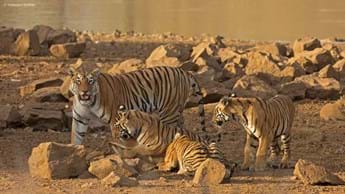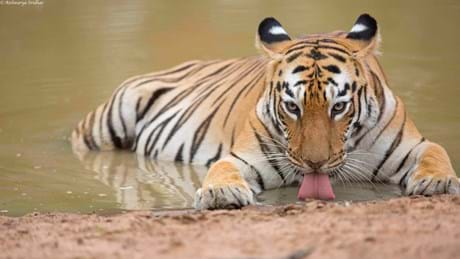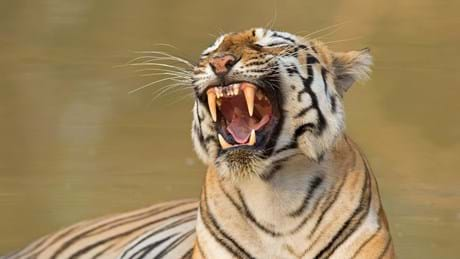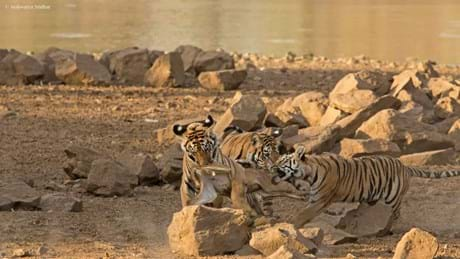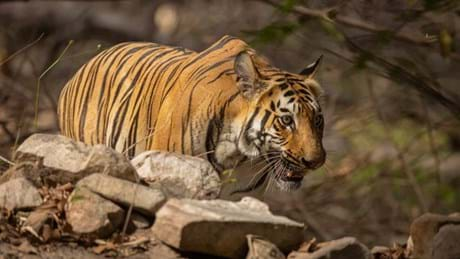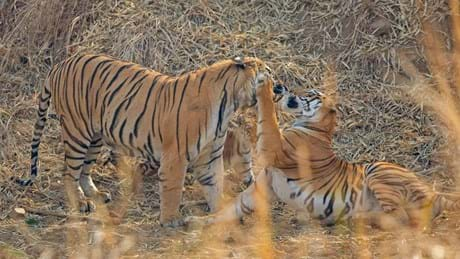Making A Perfect Planet on BBC Earth (DStv 184)
22 February 2021A Perfect Planet was not quite ready when the COVID-19 pandemic struck. Here’s how the production team and Sir David Attenborough worked together to get it across the line.
Aishwarya Sridhar talks about how she brought us Maya the tiger’s remarkable tale of survival and how she has become one of India’s best-loved big cats
In Tiger Queen of Taru, award-winning 24-year-old filmmaker Aishwarya Sridhar tells the dramatic story of Maya the tigress, one of the best-loved tigers in the Tadoba Andhari Tiger Reserve in Central India (the name Tadoba comes from the god, Tadoba or Taru, who was killed in a fight with a tiger), using footage gathered from the filmmaker’s friends as well as original film she shot herself.
These days, Maya the tigress makes headlines in India. Sightings fill blog posts, Twitter posts about her go viral. She’s a celebrity, and like many celebrities, she had something of a rough start in life. Tiger cubs normally stay with their mothers, being protected and learning to hunt until they’re around 2 years old. But Maya’s mother, Nira, died when she was too young to even have started hunting for herself.
“We got to know that she was having a really tough time to survive and was scavenging off the remains of other predators' kills. These were other tiger and leopard kills and we didn't know if she'd make it. But she became the Queen of Tadoba. She rose to take up the mother's throne,” says Aishwarya. “Her siblings walked away. She didn't even have to fight for the throne because her siblings left the area and she just claimed it. And one fine day, we saw her at Pandharpauni Lake, marking territory and taking over her mother's range. And she’s expanded her mother's territory to a much larger area.”
Aishwarya, who’s been a frequent visitor to Tadoba since she was a teenager, actually started filming Maya when she was a little cub, unaware that one day the little stripey bundle would become the undisputed queen of the forest.
Now in Tiger Queen of Taru, the final film of Big Cat Month on National Geographic Wild (DStv channel 182), Aishwarya takes us inside the epic tale of Maya’s life which is filled with tragedy, romance, family and many dangerous lovers. “I hope that it changes people's perception of tigers and that they can look at tigers in a whole new way as creatures who are capable of strategising, of thinking. They are creatures who have a human side to them as well,” says Aishwarya.
Watch National Geographic Wild now
How did you come to make this film?
Aishwarya: She was a small cub when I first saw her. I think she was about a couple of months. When I entered the Tadoba for my first safari, I saw Maya with her siblings and it kind of remained with me. That was somewhere around 2012. I was 15 then. And then I began collecting videos or photos just for my passion. I was just following her because I felt that she was different and there was this kind of bond that I had with her because she was one of the first tigers I saw at Tadoba. I used to keep tabs on her, keep a check as to what she's up to and all that with my local friends as well. I didn't have in mind that I wanted to do a documentary as such, but there were a couple of incidents in her life which made me feel that she was redefining her wild genetics and I wanted to bring that part out to the world. Since she had never been filmed (for TV) before, I thought, why not be the first person to do a documentary on her and show the world that big cats can think and act like humans? I decided to make the film (when Maya was about 4 years old – she’s 9 now) and she had already become a celebrity. She’s in her prime right now.
How did you gather all your footage?
Aishwarya: The story has taken 6 years to develop because it's 6 years of her life in the film. All the people who have contributed the footage to my film are my friends. I've been working with them since I was a child. They all know me, they've seen me grow up, so they were also excited that I was making a film on Maya. They all equally love Maya. We all wanted to see her on screen. I was collecting videos and stills as well, so that kind of came in handy when I decided to make the film because I could use her past footage, create her life and build her whole life story.
What were some of the exciting developments that happened while you were filming?
Aishwarya: Definitely seeing when she trained her cubs to hunt not once but twice. To see that live action happening in front of your eyes is very rare in the wild because tigers usually hunt behind the thickets and not in the open. To get a tiger hunt is rare, but to see a mother training her cubs is rarer. She did that twice, right out in the open in front of all of us, so that was striking and a thrilling experience for me. There's also been the fact that wild dogs attacked her cubs the first time. She had her first litter, and we saw the first litter when she brought them out. She was very young at that time. She was inexperienced at motherhood so she was a little careless with her cubs. Wild dogs took the opportunity. She didn't know how to handle motherhood at that time and they killed her 2 cubs and I was right there. It was sad at that moment as well, for the fact that she lost her cubs and for the next 2-3 days she continuously kept calling out to them. It brought tears to my eyes when I saw that.
One of the extraordinary scenes in the documentary is one of Maya’s mates, Matkasur, fighting a sloth bear. How did you come by that?
Aishwarya: That was actually filmed by my friend because I had my board exams at the time. I remember coming out of my exam paper and he called me and told me that Matkasur had fought with a sloth bear and I was like, “Wow! Did you catch it on camera?” It's a rare moment to see a sloth bear with a tiger. They faced off and they had a brutal fight and Matkasur was injured. The sloth bear was also injured, but thankfully both survived.
You’ve linked that fight with Matkasur finally leaving Maya’s territory. How long did that take to happen?
Aishwarya: It took a couple of months. The cubs were also growing up and I felt that possibly she started distancing herself from Matkasur when earlier she was sighted with him and the cubs very often. Then it was more her with the cubs and less Matkasur. Then one fine day, we saw that Matkasur was no longer in the area, but a new male was with her.
What happened when you thought, okay, I have all this footage, it’s time to stop and tell her story?
Aishwarya: I didn't know what to include and what to exclude with that much footage I had. Her story is so complex. It has so many different elements to it that I was very confused and it was challenging to put together the entire film because I had no clue as to which part I should include. But thankfully Earth-Touch (Tiger Queen’s original South African-based production company) guided me, they took my hand through the entire process of the broadcasting network and introduced me to this whole new world that I previously had not known. They helped me edit it and build the storyline. So yeah, I'm very, very grateful to the entire team of ET. I learnt that it’s important to have a compelling story, a narrative, which draws the audience towards watching your visuals. I realised that it's important not to include too many different characters in it. Originally, I had her former mate as well. I realised that I had to chop some elements off to get a more tighter-knit story.
What sort of research have you done on tigers and what have you learnt about them?
Aishwarya: All my research that I learnt about tigers was on the ground, seeing Maya, documenting her behaviour, spending time with her. I did read up a couple of research papers and articles about tigers because previously there was no record of tigers false-mating (as we see Maya do in the film) to secure their litter. She defied the law. She absolutely did that, and she brought her former mate back to kick out the intruder. She false-mated with him, then went back and rejoined her cubs. That saga was like a Bollywood movie. I could not film the former mate and the intruding tiger’s fight because that happened in the night and it was inside the bushes. The Forest Guards told me they could hear the noises, but no one really saw the fight. The next day we saw both the males injured, so we kind of guessed that there was a fight, then Matkasur left the area and Gabbar also left. Then Matkasur came back and reclaimed it and Maya became his. There are very few big cats that have such a striking story as Maya.
Where do tigers stand in the culture around Tadoba?
Aishwarya: India is a country with a lot of different big cats. You have the leopard, the Asiatic lion, the tiger, the snow leopard, the clouded leopard. There are even smaller cats as well in India, but I find the tiger a very enigmatic species. There's folklore. There is culture, this tradition, and there's also the natural history element to it. In Tadoba, they view the tiger as Lord Waghoba and they consider the tiger to be sacred. Even when the tiger kills humans or they kill cattle, there is no revenge killing that happens in Tadoba among the farmers and the local communities. They take it as part and parcel of their life, which is incredible. Even before you enter the forest, all the locals and the tourists are made to greet Lord Waghoba so that we can see the tiger in its natural element. Tadoba is one of the best-managed parks. Although it gets a huge influx of tourists every year, in terms of its conservation and in terms of handling the tourism traffic inside the park, it's incredible the way they do it.
And the Forest Guards were a big help during this project…
Aishwarya: They tirelessly work with passion to protect the big cat. I had lovely guides who were so knowledgeable. They could absolutely predict the tigers’ movements. We were following Matkasur and I had missed seeing him the first time. A Forest Guard told us that he had climbed a hill, so they made this incredible prediction. One guard said, “We'll go around the hill. He will come out. I was like, “Are you sure because I don't know if he's climbed the hill. We don't know if he'll even come out. He might even rest inside the forest”. He said, “This is his path at 8:30. If he came, he will correctly come out at this junction. So let's go and wait there.” So we went there, we waited and I remember looking at the watch and it was correct. At 08:31, I saw Matkasur walking head-on and that's one of the opening shots in the film.”
Watch Tiger Queen of Taru on Sunday, 28 February, on National Geographic Wild (DStv channel 182) at 18:00
Watch National Geographic Wild
